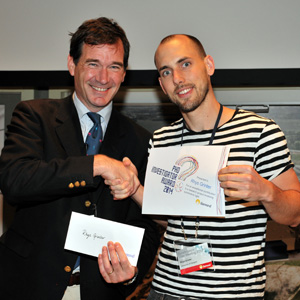"Outstanding" Rhys
Published: 9 September 2014
University of Glasgow PhD student Rhys Grinter has won the Diamond's PhD Investigator Award for Life Science.
University of Glasgow PhD student Rhys Grinter has won the Diamond's PhD Investigator Award for Life Science, writes Claire Diamond.
 The award is for ‘an outstanding contribution to a research project’ made by Grinter to his supervisor's project.
The award is for ‘an outstanding contribution to a research project’ made by Grinter to his supervisor's project.
The award is given to an early-career scientist, such as PhD student or post-doctoral researchers, who have shown exceptional contribution to a research project using synchrotron light.
The UK’s synchrotron, Diamond Light Source, is one of the most advanced scientific facilities in the world.
It works to harness the power of electrons to produce bright light that scientists can use to study anything – in a similar way that a microscope is used - from fossils to jet engines to viruses and vaccines.
Dr Daniel Walker, who is Grinter's PhD supervisor and who nominated him for the award, is working to discover protein antibiotics determine how they work and applying them to combat bacterial infections.
Grinter's project identified a number of these proteins and studied their structure using an advanced X-ray technique, crystallography.
Using extremely bright focused X-rays, researchers were able to see the atomic structure of the protein antibiotics.
This allowed them to understand how the protein antibiotics kill bacterial cells.
Judges of the competition were impressed with the number of protein structures Grinter's PhD was able to identify and how his findings provided insight into the functions of the molecules.
Rhys commented: 'This award means a lot to me as it recognizes quite a lot of hard work that I’ve put in during my PhD.
'A single result in X-ray crystallography often represents months or years of work, so it’s very satisfying that top people in this field think that what I’ve achieved is important.
'Additionally, X-ray crystallography as a technique largely originated in the UK (and has subsequently formed the basis of numerous Nobel prizes) and research at Diamond has a direct pedigree to these original researchers.
'As a kid from a small town in Australia, being involved in this kind of science was some kind of impossible dream, so it’s extremely gratifying to have my research recognized in this way.'
First published: 9 September 2014
<< September

